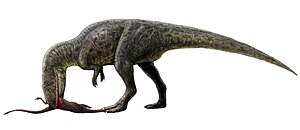Shaochilong
| Shaochilong | ||||||||||||
|---|---|---|---|---|---|---|---|---|---|---|---|---|

Artistic representation of a Shaochilong eating a Sinornithomimus carcass. |
||||||||||||
| Temporal occurrence | ||||||||||||
| Upper Cretaceous ( Turonium ) | ||||||||||||
| 93.9 to 89.7 million years | ||||||||||||
| Locations | ||||||||||||
| Systematics | ||||||||||||
|
||||||||||||
| Scientific name | ||||||||||||
| Shaochilong | ||||||||||||
| Brusatte et al. , 2009 | ||||||||||||
| Art | ||||||||||||
|
Shaochilong is a genus of theropod dinosaur from the group of Carcharodontosauridae . The only find so far, a very fragmentary skeleton, comes from the Upper Cretaceous ( Turonian ) in the Chinese province of Inner Mongolia . This find was already described by Hu (1964) as a species of Chilantaisaurus ( Chilantaisaurus maortuensis ) for the first time. Stephen Brusatte and colleagues (2009) described the find as an independent genus.
features
Shaochilong was a relatively small Carcharodontosauridae with a comparatively short snout. The skeleton found likely belonged to an adult or almost fully grown individual. Its length is estimated to be 5 to 6 meters based on the length of the row of teeth in the upper jaw. The thigh bone is estimated to be 61.5 centimeters long, which indicates a weight of about 500 kilograms. A unique feature ( autapomorphy ) of this genus is a small sagittal crest, a sharp crest about 10 millimeters high on the center line of the skull, which is formed by the pair of frontal bones . Sagittal ridges have so far only been found in representatives of the Coelurosauria .
Paleobiogeography
Shaochilong is the first undoubted representative of the Carcharodontosauridae to be discovered in Asia. Its discovery allows conclusions to be drawn about the global development of the fauna during the Cretaceous Period. The Carcharodontosauridae were probably distributed worldwide ( cosmopolitan ) and are only missing in Australia and Antarctica, two continents whose fossil record is very patchy. In addition, this find shows that Asia was no longer isolated from other continents at the time of the Turonian, but that an exchange of fauna could already take place.
Systematics
Shaochilong is a member of the Carcharodontosauridae, a group within the Carnosauria . A phylogenetic analysis comes to the result that Shaochilong belongs to the derived (advanced) Carcharodontosauridae, so it was not at the base of the family tree of this group. It was more closely related to genera from South America and Africa ( Giganotosaurus , Mapusaurus , Tyrannotitan and Carcharodontosaurus ) than to genera from Europe and North America (such as Neovenator and Acrocanthosaurus ). The contemporary, but much larger Chilantaisaurus is also assigned to the Carcharodontosauridae, but belongs to a more original subgroup (the Neovenatoridae ). The finding that two representatives of the Carcharodontosauridae occur side by side during the middle Cretaceous period is an indication that the Carnosauria were still the dominant theropod group in the northern continents ( Laurasia ) at this time , and that the tyrannosaurs only appeared in the late Cretaceous period prevailing group.
Relationships in Shaochilong , according to Brusatte and colleagues, 2009 |
Find and naming
The only find ( holotype , copy number IVPP V2885.1-7) consists of a well-preserved brain skull , parts of the facial skull ( frontal bone , parietal bone and nasal bone), an upper jaw , the second cervical vertebra (axis) and six caudal vertebrae. These bones probably belonged to a single individual. The find comes from the Ulansuhai Formation . Other dinosaur finds from this formation include the neovenatorid Chilantaisaurus , the ornithomimosaur Sinornithomimus , the ankylosaur Gobisaurus and an iguanodontid.
The genus Shaochilong was first scientifically described by Brusatte and colleagues in 2009 . The name comes from Chinese and means something like "shark tooth dragon" ( shaochi - "shark tooth", long - "dragon").
Individual evidence
- ^ Gregory S. Paul : The Princeton Field Guide To Dinosaurs. Princeton University Press, Princeton NJ et al. 2010, ISBN 978-0-691-13720-9 , p. 98, online .
- ↑ Stephen L. Brusatte, Daniel J. Chure, Roger BJ Benson, Xing Xu: The osteology of Shaochilong maortuensis, a carcharodontosaurid (Dinosauria: Theropoda) from the Late Cretaceous of Asia. In: Zootaxa . Vol. 2334, 2010, pp. 1-46, digitized version (PDF; 2.54 MB) .
- ↑ a b c d e f Stephen L. Brusatte, Roger BJ Benson, Daniel J. Chure, Xing Xu, Corwin Sullivan, David WE Hone: The first definitive carcharodontosaurid (Dinosauria: Theropoda) from Asia and the delayed ascent of tyrannosaurids. In: Natural Sciences . Vol. 96, No. 9, 2009, pp. 1051-1058, doi : 10.1007 / s00114-009-0565-2 .
- ↑ Stephen L. Brusatte, Roger BJ Benson, Xing Xu , Xing Xu: The evolution of large-bodied theropod dinosaurs during the Mesozoic in Asia. In: Journal of Iberian Geology. Vol. 36, No. 2, 2010, ISSN 0378-102X , pp. 275-296.
- ↑ David B. Weishampel , Paul M. Barrett, Rodolfo A. Coria , Jean Le Loeuff, Xing Xu, Zhao Xijin , Ashok Sahni, Elizabeth MP Gomani, Christopher R. Noto: Dinosaur distribution. In: David B. Weishampel, Peter Dodson , Halszka Osmólska (eds.): The Dinosauria . 2nd edition. University of California Press, Berkeley CA et al. 2004, ISBN 0-520-24209-2 , pp. 517-606, here pp. 563-570.
Web links
- Shark toothed theropods in Asia - introducing Shaochilong on Discoverers' Blog, English.